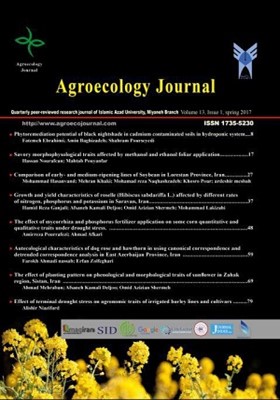Determining of Suitable Cultivation Date for Wheat in Kosar Irrigation Network to Decrease Water Stress Effects using AquaCrop
Subject Areas : Agroecology JournalMaryam Abedi 1 , Aslan Egdernezhad 2 * , Niaz Ali Ebrahimipak 3
1 - Department of Water Sciences and Engineering, Ahvaz Branch, Islamic Azad University, Ahvaz, Iran
2 - Department of Water Engineering and Sciences, Ahvaz Branch, Islamic Azad University, Ahvaz, Iran
3 - Associated professor, Department of irrigation and soil physics, Soil and Water Research Institute, Agricultural Research, Education and Extension Organization (AREEO), Karaj, Iran.
Keywords: Crop Modeling, Cultivation Decade Time, Kosar Plain, Irrigation Management, Water-driven Model,
Abstract :
Since cultivation time have important role on wheat yield in Khuzistan province, calibrated AquaCrop was used in this study so as to determine the effect of cultivation time in three pilots in Kosar irrigation network. Considering that wheat is cultivated on November, three dates in each decade were chosen for simulation. The results showed that AquaCrop had good accuracy for simulation of wheat yield and water use efficiency. EF and d values for yield (0.6 and 0.99) and water use efficiency (0.08 and 0.99) revealed that this model had acceptable efficiency. Results showed that wheat yield for first, second and third decade were 3.5, 3.6 and 3.7 ton.ha-1, respectively. Average yield in pilot 1, 2 and 3 were 3.9, 3.6 and 3.2 ton.ha-1, respectively. Water use efficiency for first, second and third decade were 1.06, 1.05 and 1.05 kg.m-3, respectively. Average water use efficiency for pilot 1, 2 and 3 were 0.94, 1.07 and 1.15 kg.m-3, respectively. If it is necessary to increase yield, it is necessary to cultivate wheat in third decade of November. Beside this, it is recommended to manage irrigation use and decrease irrigation applied when it is raining. This leads us to increase water use efficiency.

